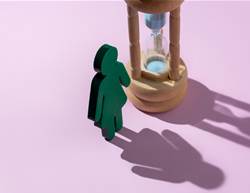It’s that dreaded moment when heat takes over, which up to 80% of women experience during menopause. If you’re one of them, you may not be able to beat ’em, but knowing what’s going on can at least help.
It starts with your ovaries ...
Your ovaries churn out two essential hormones: oestrogen and progesterone. When you enter perimenopause your ovary function begins to decline, and the amount of these two hormones declines along with it. This drop in oestrogen throws off your body’s “thermostat”, a gland called the hypothalamus at the base of your brain.
“As oestrogen levels fall, certain triggers can provoke increased body heat,” explains Dr Elizabeth Farrell, gynaecologist and medical director at Jean Hailes for Women’s Health. “To reduce these common triggers, cut back on caffeine, alcohol and spicy foods and try to reduce your stress levels.”
Then your brain kicks in
A sudden drop in oestrogen confuses the hypothalamus, which produces hormones that control hunger, mood and body temperature.
This is what happens to your hormones
With excess heat, an alarm is triggered in your brain, sending hormones such as adrenalin and prostaglandins (which respond to inflammation)through your system, turning on cooling mechanisms in the skin, heart and sweat glands.
It can also affect your mood
Some women feel tension or dread before a hot flush; others experience an aura – visual symptoms such as seeing dark spots or flashing lights, caused by changes in the cortex area of your brain. Forewarned is forearmed.
This is what happens to your skin
Temperatures can rise by up to two degrees during a hot flush, which can feel like an extreme change. Luckily, your core body temperature will not rise above the normal 36-37°C. Blood vessels near the surface of your skin will widen to release heat. As a result, your skin may also redden, as if you are blushing, and become blotchy.
How it effects your heart
During a hot flush your heart rate might increases by 8 to 16 beats, which can intensifying the sensation of heat.
“When anxious or stressed, menopausal women also release slightly higher amounts of the stress hormone noradrenalin, which also increases body temperature,” says Farrell. The good news? Women who suffer from hot flushes and night sweats may be at lower risk of heart disease and stroke, research shows.
How your sweat glands react
To cool down, sweat glands release perspiration that evaporates, lowering your temperature and ultimately, cooling you off. To help speed this process, imagine a snowscape – research shows that visualising cool places can help some women reduce hot flushes by 68%.
Did you know?
Although hot flushes usually are considered a menopausal issue, men can have hot flushes too. They occur when the levels of the male sex hormone testosterone drop suddenly and dramatically. For example, Harvard Health reports hot flushes occur in 75% of men with prostate cancer who have surgery to remove the testes (orchiectomy) or who take medication to decrease testosterone levels.
(Want to pick up some healthier habits? Sign up for FREE to get healthy living tips, weight loss inspiration, slimming recipes and more delivered straight to your inbox!)









